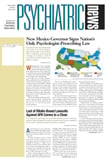It’s looking more and more as though the prefrontal cortex—that region of the brain above the eyes and behind the forehead involved in judgment, planning, and decision making—is not working right in criminals and potential criminals. For instance, Adrian Raine, Ph.D., a professor of psychology at the University of Southern California, found that prefrontal cortex volume was significantly smaller in violent, antisocial men than in controls (Psychiatric News, March 3, 2000).
And now yet another investigation implicating the prefrontal cortex with criminality has been conducted by Lance Bauer, Ph.D., and Victor Hesselbrock, Ph.D., professors of psychiatry at the University of Connecticut School of Medicine in Farmington. The results were published in the October 15, 2001, Biological Psychiatry.
Bauer and Hesselbrock selected 158 boys and girls aged 14 to 20 years as their subjects. Half had exhibited conduct disorder according to DSM-III-R criteria, and half had not. They placed 32 electrodes in various locations on their subjects’ scalps. The subjects were then given a memory task—they were asked to judge whether various stimuli had been presented. While they were engaging in the memory task, the electrodes on their scalps were recording brain-wave responses in various areas of their brains. Bauer and Hesselbrock measured these brain-wave responses.
Bauer and Hesselbrock then compared brain-wave responses of the subjects who had conduct disorder with those of subjects who had not. They found that subjects without the disorder had exhibited robust brain-wave responses in the prefrontal cortex during the memory task, whereas subjects with the disorder did not. There were no significant differences in brain-wave responses between the two groups of subjects in brain areas other than the prefrontal cortex. Also of interest, the results localized the brain-wave deficits to the left prefrontal cortex. However, a similar experiment conducted by the researchers in 1999 localized the brain-wave deficits to the right prefrontal cortex.
Bauer and Hesselbrock concluded that “the neurophysiologic substrate underlying conduct-problem behaviors is bilaterally represented within the prefrontal cortex.”
Psychiatric News asked Peter Finn, Ph.D., a psychologist at Indiana University doing similar kinds of research, for his comments on the study.
“I have high regard for Drs. Bauer and Hesselbrock,” he said. “They are well known in the field of the psychobiological bases of conduct problems and social pathology, and their work is very rigorous.”
As for this particular study, Finn said, he believes that its strength lies in the fact that Bauer and Hesselbrock took a topographical approach to identifying the biological origins of prefrontal cortex abnormalities in youngsters with conduct problems.
“The fact that the study had a pretty large sample size and was collected for the most part from the community was also important,” he added. “It was a sample that you could be confident was representative to some degree of the individuals who have these kinds of conduct problems.”
This study was supported in part by a Public Health Service grant. ▪
